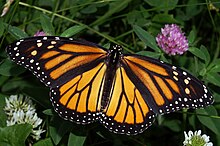From Wikipedia, the free encyclopedia
The monarch butterfly or simply monarch (Danaus plexippus) is a milkweed butterfly(subfamily Danainae) in the family Nymphalidae. Other common names depending on region include milkweed, common tiger, wanderer, and black veined brown. It may be the most familiar North American butterfly, and is considered an iconic pollinator species. Its wings feature an easily recognizable black, orange, and white pattern, with a wingspan of 8.9–10.2 cm( 31⁄2–4 in) The viceroy butterfly is similar in color and pattern, but is markedly smaller and has an extra black stripe across each hindwing.
| Monarch butterfly | |
|---|---|
 | |
| Female | |
 | |
| Male |
The eastern North American monarch population is notable for its annual southward late-summer/autumn migration from the northern and central United States and southern Canada to Florida and Mexico. During the fall migration, monarchs cover thousands of miles, with a corresponding multi-generational return north. The western North American population of monarchs west of the Rocky Mountains often migrates to sites in southern California but has been found in overwintering Mexican sites as well. Monarchs were transported to the International Space Station and were bred there.
...
The name "monarch" may be in honor of King William III of England
...
There are three species of monarch butterflies:
- D. plexippus, described by Linnaeus in 1758, is the species known most commonly as the monarch butterfly of North America. Its range actually extends worldwide and can be found in Hawaii, Australia, New Zealand, Spain and the Pacific Islands.
- D. erippus, the southern monarch, was described by Pieter Cramer in 1775. This species is found in tropical and subtropical latitudes of South America, mainly in Brazil, Uruguay, Paraguay, Argentina, Bolivia, Chile and southern Peru. The South American monarch and the North American monarch may have been one species at one time. Some researchers believe the southern monarch separated from the monarch's population some 2 mya, at the end of the Pliocene. Sea levels were higher, and the entire Amazonas lowland was a vast expanse of brackish swamp that offered limited butterfly habitat.[13]
- D. cleophile, the Jamaican monarch, described by Jean Baptiste Godart in 1819, ranges from Jamaica to Hispaniola.
...
Distribution and habitat[edit]
The range of the western and eastern populations of the monarch butterfly expands and contracts depending upon the season. The range differs between breeding areas, migration routes, and winter roosts. However, no genetic differences between the western and eastern monarch populations exist; reproductive isolation has not led to subspeciation of these populations, as it has elsewhere within the species' range.
In North America, the monarch ranges from southern Canada through northern South America. It has also been found in Bermuda, Cook Islands, Hawaii, Cuba, and other Caribbean islands the Solomons, New Caledonia, New Zealand, Papua New Guinea, Australia, the Azores, the Canary Islands, Gibraltar, the Philippines, and North Africa. It appears in the UK in some years as an accidental migrant.
Overwintering populations of D. plexippus are found in Mexico, California, along the Gulf Coast, year round in Florida, and in Arizona where the habitat has the specific conditions necessary for their survival. On the US East Coast, they have overwintered as far north as Lago Mar, Virginia Beach, Virginia. Their wintering habitat typically provides access to streams, plenty of sunlight (enabling body temperatures that allow flight), and appropriate roosting vegetation, and is relatively free of predators. Overwintering, roosting butterflies have been seen on basswoods, elms, sumacs, locusts, oaks, osage-oranges, mulberries, pecans, willows, cottonwoods, and mesquites. While breeding, monarch habitats can be found in agricultural fields, pasture land, prairie remnants, urban and suburban residential areas, gardens, trees, and roadsides – anywhere where there is access to larval host plants. Habitat restoration is a primary goal in monarch conservation efforts. Habitat requirements change during migration. During the fall migration, butterflies must have access to nectar-producing plants. During the spring migration, butterflies must have access to larval food plants and nectar plants.
Pictorial life cycle[edit]
Migration
In the U.S., the eastern population migrates both north and south on an annual basis. The population east of the Rocky Mountains migrates to the sanctuaries of the Mariposa Monarca Biosphere Reserve in Mexico and parts of Florida. The western population overwinters in various coastal sites in central and southern California. The overwintered population of those east of the Rockies may reach as far north as Texas and Oklahoma during the spring migration. The second, third and fourth generations return to their northern locations in the United States and Canada in the spring. Captive-raised monarchs appear capable of migrating to overwintering sites in Mexico, though they have a much lower migratory success rate than wild monarchs do. Recent discoveries have located monarch overwintering sites in Arizona
...
Human interaction
The monarch is the state insect of Alabama,Idaho, Illinois, Minnesota, Texas, Vermont, and West Virginia.Legislation was introduced to make it the national insect of the United States, but this failed in 1989 and again in 1991.
A growing number of homeowners are establishing butterfly gardens; monarchs can be attracted by cultivating a butterfly gardenwith specific milkweed species and nectar plants. Efforts are underway to establish these monarch waystations.
An IMAX film, Flight of the Butterflies, describes the story of the Urquharts, Brugger and Trail to then unknown migration to Mexican overwintering areas.
Sanctuaries and reserves have been created at over-wintering locations in Mexico and California to limit habitat destruction. These sites can generate significant tourism revenue.
Organizations and individuals participate in tagging programs. Tagging information is used to study migration patterns










No comments:
Post a Comment